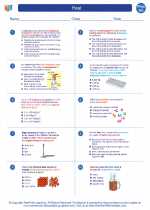Force
Force is a vector quantity that is used to describe the interaction between objects. It is a key concept in the field of physics and plays a fundamental role in understanding the behavior of objects in the universe.
Types of Forces
There are several types of forces, including:
Newton's Laws of Motion
Newton's laws of motion describe the relationship between an object and the forces acting on it. The three laws are:
- Newton's First Law: An object at rest will stay at rest, and an object in motion will stay in motion with a constant velocity unless acted upon by a net external force.
- Newton's Second Law: The acceleration of an object is directly proportional to the net force acting on it and inversely proportional to its mass.
- Newton's Third Law: For every action, there is an equal and opposite reaction.
Calculating Force
The force acting on an object can be calculated using the formula:
F = ma
where F is the force, m is the mass of the object, and a is the acceleration.
Units of Force
The SI unit of force is the newton (N). Other units include the dyne and the pound-force.
Applications of Force
The concept of force is applied in various fields, including mechanics, engineering, and astronomy. Understanding force is crucial for designing structures, analyzing motion, and predicting the behavior of celestial bodies.
Study Tips
When studying force, it's important to:
- Understand the different types of forces and their characteristics.
- Practice applying Newton's laws of motion to solve problems.
- Master the calculation of force using the formula F = ma.
- Explore real-world examples of forces in action, such as the motion of vehicles, the behavior of objects in space, and the operation of machines.
- Review key concepts and definitions to build a strong foundation in the topic.



